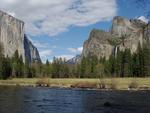>Tell me, did YOU choose these settings randomly, or did your light meter suggest them...you have no idea how long I have been pursuing this sort of pic
Settings weren't chosen randomly, I usually shoot in 'aperture priority' mode - choosing my preferred aperture setting (wide open in both of my pics here, which gave me the fastest shutter speed for a given amount of light - so that way there's the least chance of blur), and letting the camera adjust the shutter speed.
Getting detail in the moon & landscape together is usually best around dawn & sunset, when the brightness of the moon closely matches the sky brightness. You can use a spot meter to tell exactly how far apart they are - i.e. the meter says the moon is 1/500 at f4.5 and the sky is 1/60 at f4.5, they're two stops apart (1/500 --> 1/125 --> 1/60), that's within the camera's four or five stop exposure range.
I think it's super important to keep in mind that the camera doesn't see like the eye sees.
There are resources around that can tell you when the moon will rise and at what azimuth, so if you have a certain scene in mind, you can figure out when the moon will be there.
Cheers and have fun!
Ron














